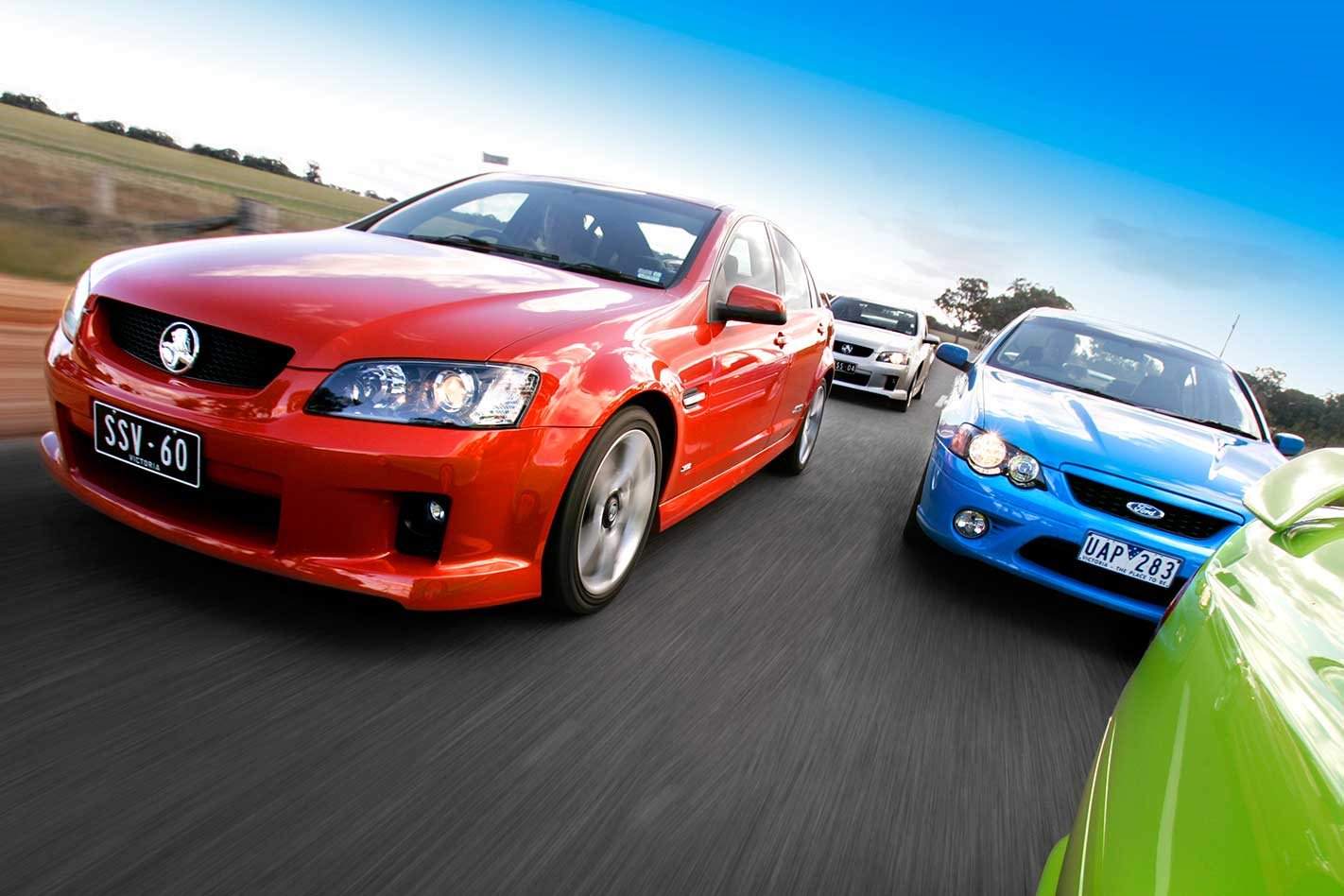Holden can bang on all it likes about how the VE Commodore was benchmarked against cars like the BMW 5-Series. But let’s get one thing straight right now: The real target in the VE’s cross-hairs is none other than old mate Falcon. Nothing is going to alter the fact that a good old Holden versus Ford stoush is what we now have on our hands with the launch of the billion-dollar VE.
This feature was originally published in MOTOR’s October 2006 issue
While the blokes in the baggy trunks might be from the same gym as before. the ring itself ain’t the same. Honest, hardworking. God-fearing folks are deserting the big car market.

Without wishing to scare the horses, local big cars haven’t been in it this deep for a long time. But neither Holden nor Ford is giving up on the concept and the new VE is proof of that commitment. Not only is the VE a major improvement over the VZ, it’s also a damn good car in its own right. That stuff about Holden’s 5-Series benchmarking? Believe it.
Of most interest to tight-minded folks like you and me, of course. is the SS model which has been repositioned to better reflect the original concept; that is. a model that delivers all the performance you need but without the sticker shock.
And just to make sure that those with more cash to splash aren’t ignored, there’s also the better equipped SS V model which runs the same driveline but adds more fruit inside and externally it gets the 19-inch wheels and tyres over 18-inchers.
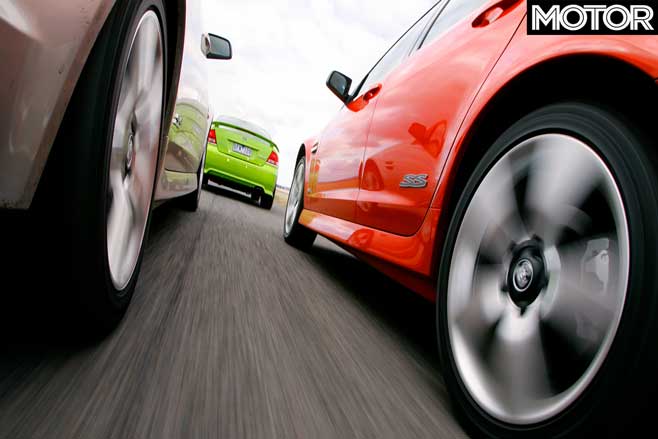
Down at Ford. meanwhile, the BF Series 2 is waiting in the wings. but mechanically, it’s not a real departure from the current BF. In fact. the performance versions have been deemed to be so spot-on. Ford hasn’t even bothered to alter the appearance fat the Series 2 as it has with the more pedestrian stuff.
So, buying a Series I XR now won’t leave you stranded with last year’s look before Christmas has even rolled around. On paper, the BF 2 that competes with VE SS most completely is the XR8. Like the VE, it’s a big V8 with tin this case) a six-speed manual gearbox. So we’ve snavelled one for this match.
But muddying the waters a little is Ford’s XR6 Turbo, which has been so well received that it’s a cult car long before it should have been. Straight six, blower, V8 performance levels; the XR6T has got it all with the promise of better economy and a more high-tech smell and taste to appeal to those who know that an X-Box has nothing to do with a former spouse.

The turbo-motor pumps out 245kW of seamless urge with a torque curve that is flatter than the Hay Plain. The six is a much better unit when teamed with an auto; the way the engine makes torque almost from idle and the way an auto converter allows it to spool up boost when you’re not even looking makes it a cinch for a slushbox. Even in the old days when the auto du jour was a four-speeder, the XR6T was a happier camper without a clutch pedal.
Of course, while high-tech is the six’s middle name, the Ford V8 is also a pretty sophisticated piece of work. Gone are the pushrods and two-valve head of previous Ford bent eights, and in are double overhead camshafts on each bank and four valves for every cylinder. Call it 260kW with a whole lot of smoothness.
The Holden’s V8 is also a smoothie (albeit with a duff engine note thanks to the Gen 4’s el weirdo firing order) but it’s old school with those pushrods and two-valve heads. But 6.0-litre are 6.0-litres and with a whopping 270kW at its disposal, even a dinosaur spec sheet ceases to matter.
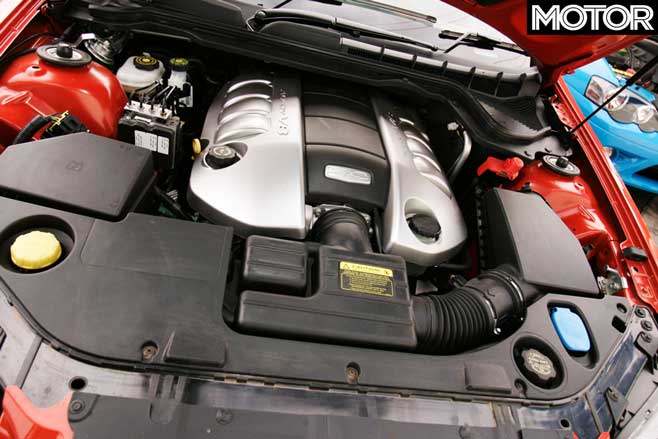
In fact, it ceases to matter in exactly 13.8 seconds, because that’s how long it took either Holden to blast down the quarter mile. Terminal velocity was 171.1km/h for the SS V and 171.4km/h for the SS, suggesting that GM’s Silao plant in Mexico, which builds the V8, isn’t having any poor-tolerance issues.
Along the way, you can expect a 0-60km/h time of 2.9 seconds and a 100km/h dash in 5.6sec. Launching the Holden requires a bit of finesse, though, as it’s all too easy to dial up too many revs for the launch and have the whole thing go up in smoke.
You’ve then got to deal with a pretty cranky gearshift action which is at its worst on the two-three shuffle. It’s way too easy to get the shifter hung up on the centre gate and buzz the engine in the process.

Even though it uses the same gearbox, Ford has spent a lot of time improving the shift action. The XR8’s shifter uses bearings instead of bushes and feels more positive and accurate as a result. The proof is in the shifting, too, and the Falcon never threatened to leave us stuck in neutral even during the fastest of gear changes.
Yet the Falcon can’t keep up with the Holdens. Even with repeated runs (that tested the clutch’s patience) we couldn’t get the XR8 down the quarter in anything less than 14.4sec with a terminal speed of 164.0km/h. From the same standing start, you’re looking at 3.2sec for the sprint to 60km/h from rest and then 6.25ec for the 100km/h.
The engine is clearly making plenty of power at the top end; it’s all stacked way up beyond 4000rpm. This doesn’t matter at all on the drag-strip once you’ve got it going, but it does mean the XR8 can’t launch as hard as you’d like. Too many revs and it wheelspins, too few and you’re out of the grunt zone.
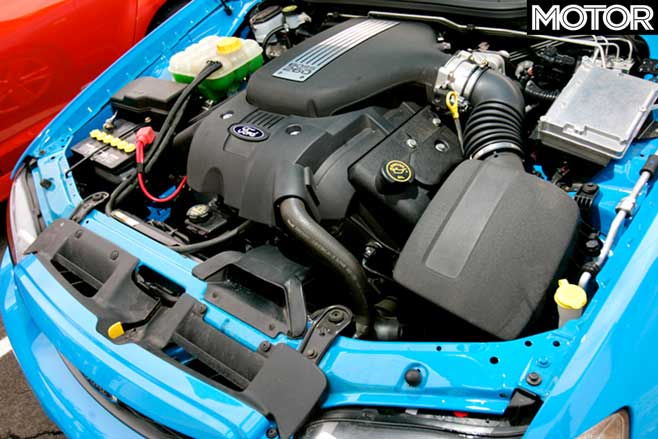
In the Turbo, however, the combination of that auto tranny and a 4500rpm spread of urge means that a 14.2 second quarter mile is as easy as standing on the picks, bringing the revs up and side-stepping the bake pedal just as the rears start to turn.
Time after time, you’ll end up doing 60km/h in 3.2sec, 100km/h in 6.1sec and you’ll be doing 167.6km/h at the end of 400m, still trailing the Holdens, but not by as much as the XR8. Oh, and don’t bother shifting gears manually; the auto transmission is smarter than you so leaving it in D for Drag is the way to go.
In a straight line, the XR6T falls somewhere between the Holdens and the XR8. But out in the real world, it’s a different matter because there’s just no substitute for having so many Newton-metres at call. In terms of having instant squirt, they don’t come much better than a blown XR6 and, combined with the smarty-pants gearbox, it makes the six easiest car to drive quickly in any situation.
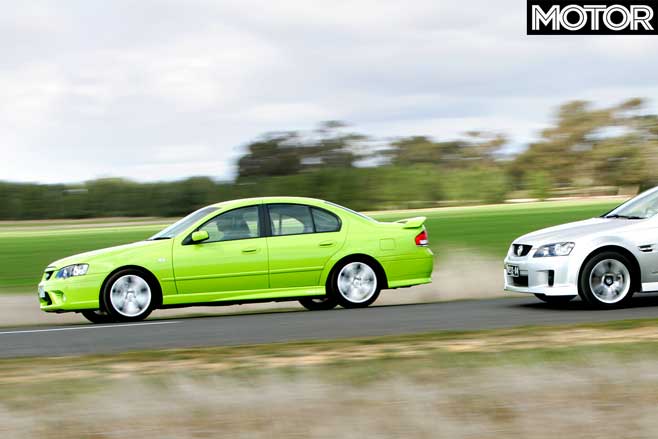
But the Holdens have closed the gap these days and while the old Gen 3 was never as torquey as it should have been, the new 6.0-litre mill is much, much handier. It still digs a rev and the pay-offs is thrust big style but there’s also plenty on tap on the first half of the tacho.
The gearing is still tall, but this time around, the sixth gear that sees doing 1500rpm at 100km/h is actually viable. These days a V8 Commodore will pull you around a B-double in top gear easily. It certainly wasn’t always this way.
This leaves the XR8. The lack of bottom-end tug means you’re constantly rowing through the box and it’s only when you’ve got the requisite 4000rpm dialled up that the V8 starts to make any sense. By then. of course, the other three cars have buggered off.
Throw in some twistiness and things get even worse for the XR8. It really does feel a generation older than the Commodore (which, of course, it is) mainly in its dull responses and feedback.
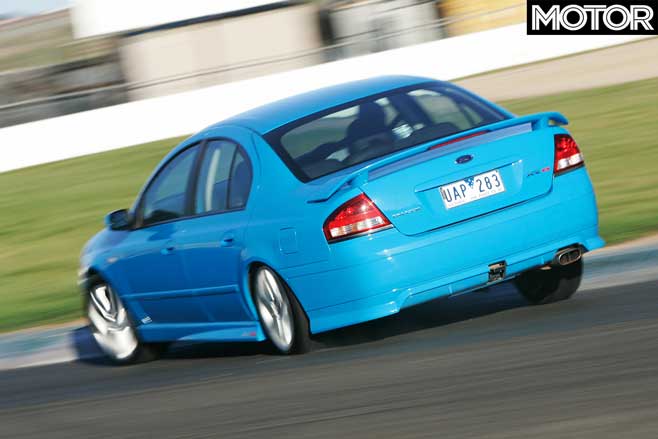
We don’t really have an issue with the rear end. but the steering is lifeless and refuses to relay any meaningful information about the status of the road or the car itself. There’s grip to be had, but you have to learn to trust the car rather than rely on it reassuring you at frequent intervals.
On a wet, windy road. it all translates to a more tippy-toe feeling; that it’ll probably keep turning in. but you won’t know it has until after you’ve apexed the thing. Throw in the too-thick steering wheel rim. and it’s a long way from perfect.
If there’s concrete evidence of the billion bucks Holden has thrown at the VE. it’s in the way the suspension works. Most notably, the front end is a million times better than any Commodore before it with good feel and lots of useful information flooding back through the tiller.
The VE sits flat and stays composed even when you provoke it but more than that, it just feels sharp and alert. It’ll change direction without protest and there’s so much info coming back at you that placing it in corners is not only easy, it’s a joy.

The ride suffers only marginally for this degree of control and while sharper bumps are felt (though not heard) the damping seems about spot on, cancelling them out on the first attempt. The only difference between the SS and the SS V comes down to tyres. the latter’s 19-inchers giving it an edge in the way it sits even flatter and conveys a tad more info about the road surface.
Somewhere between the SS and the XR8 sits the Turbo. While it shares the XR8’s lack of chat, it does steer more accurately, is easier to trust and has a much better sidestep due no doubt to having less mass over its front axle. But it is not as composed as the Holden over short, high-frequency judder-style bumps and it surely aint quite as reassuring to really punt hard.
And while it might sound like the XR8 struggles, it does come into its own on fast, bumpy back roads where its relatively soft springing and nose-heavy manners actually make it feel equal parts fool-proof and solid. Throw in the big brakes and it’s a hell of a mile-eater.
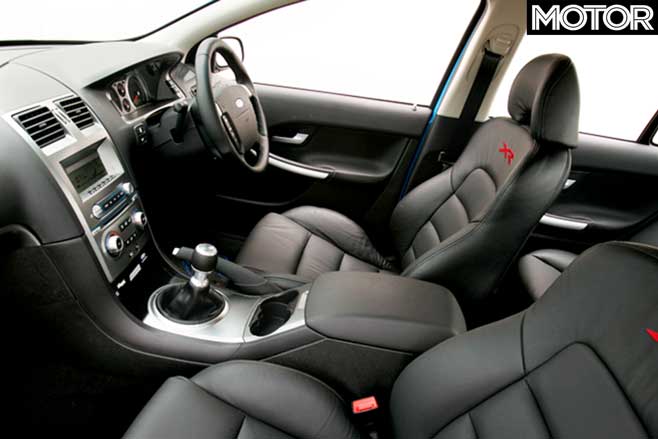
It really is as a tourer that the XR8 makes most sense and that’s only spoiled a fraction by some wind noise from the base of the windscreen (which the XR6T didn’t duplicate. so maybe that bonnet bulge is to blame). The ergonomics, meanwhile. are beaut and that’s one department where the Fords give the Holdens a thumping.
Frankly. ergonomics are one area where the VE doesn’t seem much of an advance at all. The power window switches in the centre console are in the wrong place and the temperature controls on the allegedly superior system of the SS V are confusing. And we’re still not sure about black headlining. Feels kind of enclosed to us.
The increasingly important question of fuel economy threw up some surprises. although there were no prizes for guessing that the six-cylinder Falcon was going to be up the pointy end of making the most of every litre. Even so, the Turbo’s 10.8 litres per 100km is a pretty damn good result and well ahead of anything else on test.
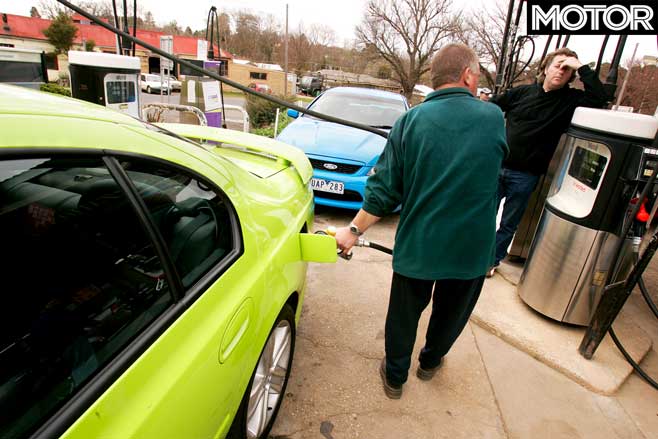
At the other end of the scale was the XR8 which gurgled premium away at a rate of 14.1 litres for every 100km. Not great at all. But the real eyebrow raiser was the difference between the two Holdens.
Driven at the same speeds over the same roads, the silver SS drank 11.2 litres per 100km while the orange SS V needed 13.4 litres every 100 kays. Weird, and it’s not a case of one engine being tighter than the other because their performance was on a par and the SS V had actually covered 1400km more than the SS.
So where does all this leave us? In a completely dispassionate. objective sense. the new VE Commodore in V8 form is the best local four-door performance car money can buy right now. The engine is right. the chassis is right and the driving experience is the best yet from a car bearing the Commodore badge. You’ll need $44,990 for the six-speed as tested here and at that price. the SS is also some kind of a bargain.
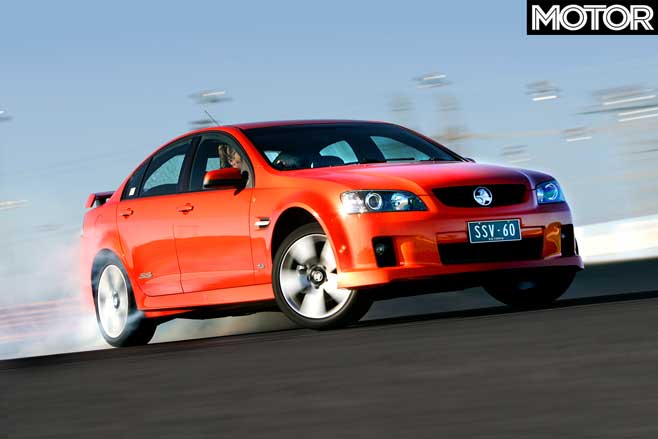
The SS V package adds curtain air-bags, a colour LCD dash display, extra gauges, a better stereo, the option of a colour-coded interior, projector headlights, climate control, sports seats and wheel, leather and the 19-inch wheels and it comes in at a much heftier $51,990. And, to be brutally honest, what it doesn’t add is any extra performance (the small amount of extra grip aside). But it is better value than the XR8, which weighs in at an almost-equally hefty $51,330.
We can’t really work out why you’d buy the XR8 and only the Ford V8-obsessed need apply. It’s off the pace and has been for some time and while the VE Commodore doesn’t change that, it certainly brings the Henry’s limitations into sharp focus.
And then there’s the Turbo. With a $47,655 price-tag in auto form (which is how you’d buy it, trust us) the XR6T is outgunned by the new Holden in some areas, but it’s still the one for anybody who gets off on a high-tech driveline that delivers a high-tech feet.
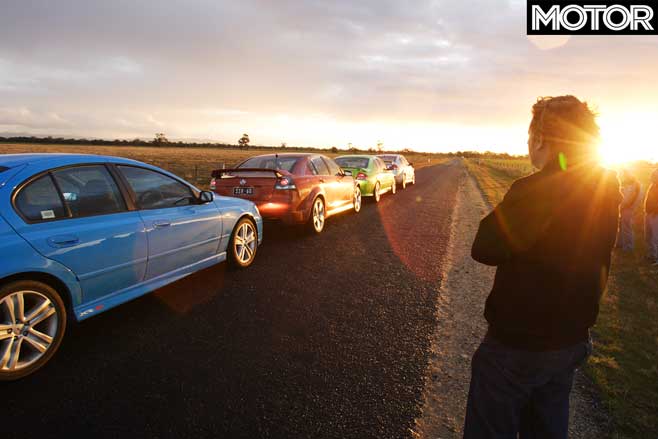
That our testers on this comparison were split about 50-50 between the SS and the Turbo gives you an idea of how good the XR6T still is.
But that doesn’t alter the final outcome which was a points decision to the SS over the Turbo with the SS V third (based on its price) and the XR8’s irrelevance earning it last spot. Wanna be king of the road? Then you need a Commodore SS, you do.
Fast Facts
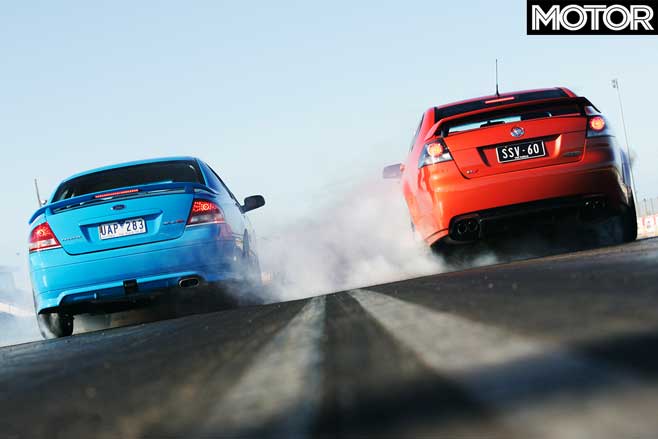
| u00a0 | Ford Falcon XR6 Turbo | Ford Falcon XR8 | Holden Commodore SS | Holden Commodore SS V |
| Body | 4-door sedan | |||
| Drive | rear-wheel | |||
| Engine | 4.0-litre inline-6 DOHC turbocharged | 5.4-litre V8 DOHC | 6.0-litre pushrod V8 | |
| Power | 245kW @ 5250rpm | 260kW @ 5250rpm | 270kW @ 5700rpm | |
| Torque | 480Nm @ 2000rpm | 500Nm @ 4250rpm | 530Nm @ 4400rpm | |
| Power/Weight | 145kW/tonne (tare) | 145kW/tonne | 160kW/tonne | |
| Transmission | 6-speed automatic | 6-speed manual | 6-speed automatic | |
| Weight | 1684kg | 1795kg | 1690kg | |
| 0-100km/h | 6.10sec | 6.20sec | 5.60sec | |
| 0-400m | 14.20sec @ 167.6km/h | 14.40sec @ 164.0km/h | 13.80sec @ 171.4km/h | 15.39sec @ 171.1km/h |
| Suspension | Independent double wishbone (f); Control Blade independent (r) | MacPherson strut, coil springs, anti-roll bar (f); Four-link, coil springs, anti-roll bar (r) | ||
| Brakes (f) | 322mm ventilated discs, two-piston calipers | 321mm ventilated discs, two-piston calipers | ||
| Brakes (r) | 328mm ventilated discs, single-piston calipers | 324mm ventilated discs | ||
| Wheels | 17.0 x 8.0-inch (f & r) | 18.0 x 8.0-inch (f & r) | 19.0 x 8.0-inch (f & r) | |
| Tyre Sizes | 235/45 R17 (f & r) | 245/40 R18 (f & r) | 245/45 R18 (f & r) | 245/40 R19 (f & r) |
| Tyres | Dunlop Sport SP 9000 | Bridgestone Potenza | ||
| Price | $47,655 | $51,330 | $44,990 | $51,990 |
No More SV8
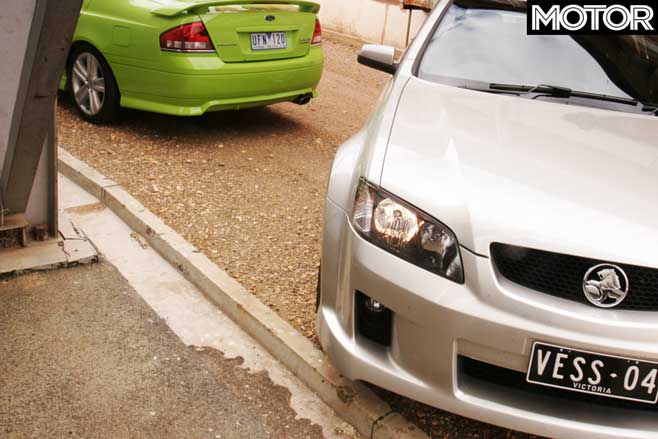
The trouble all started when Holden introduced the VY SV8. The SS had started to creep towards $50k, so Holden filled the low-$40k gap with the SV8. Naturally the SS had more gear than the SV8 to justify its price and carried more weight. The result? The SV8 was faster. Holden won’t fall for that one again; as with all VEs, the new SS is so sharply priced ($44,990, $600 more than the outgoing VZ SV8) that it makes the SV8 redundant.
And if you want your VE to have the performance theme but with a touch more luxury, you can buy the SS V for $51,990. The SS V adds 19-In rims, multifunction dash display, curtain airbags, dual-zone air and a 230W stereo tor the $6k over VE SS, but costs just $200 more than the outgoing VZ SS.
The Turbo Story
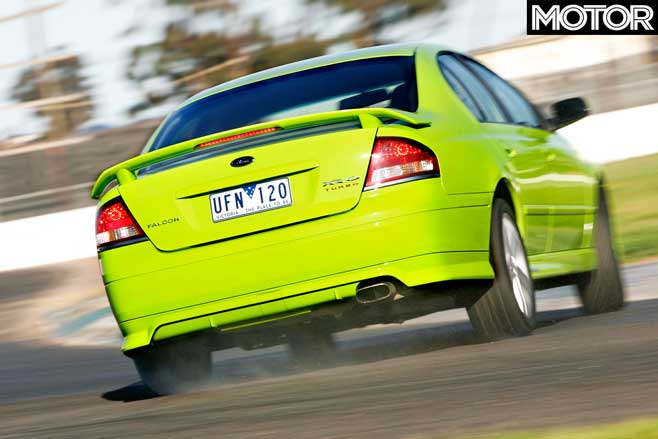
When the XR6 was introduced in the EB Falcon it barely caused a ripple. It wasn’t a home-grown hot six in the vein of Torana XU-1 or Charger E38. Even when the variable-valve timing atmo engine was introduced in the 1998 AU, the XR6 was not really the Ford to stick it up to the General’s best.
That all changed for the BA, where Ford bolted on a turbo to bump up power output from the atmo six’s 172kW to 240kW. Suddenly the rules changed and this is the hot Falcon you won’t be shy to tine-up against the General’s Commodore SS, and in fact it’s one of the best tout hot sedans you can buy.
Hot SS History
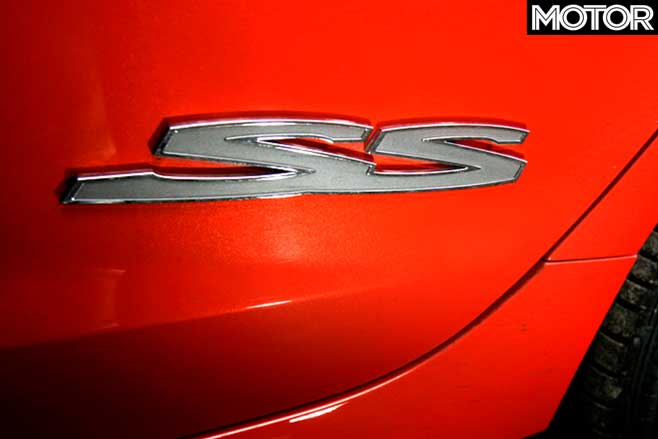
Holden borrowed the SS moniker from Chev to use on a limited run of HQ V8 sedans in 1972 (the Monaro SS), which was a precursor to the GTS sedan. Next, the LX Torana used the SS name, with the 5.0-litre V8 option the most interesting. When Commodore was released in 1978, there was no sizzling sports version.
It wasn’t until the 1981 VH that Holden introduced a performance model, reintroducing the SS nameplate with a car that was based on the 4.2-litre four-barrel-carb, electronic-ignition blue engine and four-speed box.
The SS disappeared in the 1986 VL series [except for the HDT cars]. The SS V8 returned in injected 5.0-litre form for the 1988 VN. The Aussie 5.0-litre continued on through VP, VR, VS and VT but was retired at the introduction of VTII when the 5.7-litre Gen III was introduced.

